University Risk Management Report: Hybrid Passenger Vehicle Project
VerifiedAdded on 2022/10/04
|12
|3166
|60
Report
AI Summary
This report delves into the principles of risk management within the context of project life cycles, emphasizing the importance of identifying, assessing, and controlling hazards. The study begins by exploring the project life cycle, detailing its phases and implications for risk management. Part A of the report covers the project life cycle, explaining its phases and implications for risk management. Part B then shifts focus to a hybrid passenger vehicle project, analyzing the associated risks, such as battery issues and high-voltage equipment, and discussing effective risk management strategies. The report suggests solutions like using off-board and partial on-board chargers, modifying mechanical devices, and employing low-voltage machines. Finally, it examines the implications of these risk controls for the design team, highlighting improvements in design and technology to mitigate potential hazards and enhance the safety and efficiency of hybrid vehicles.
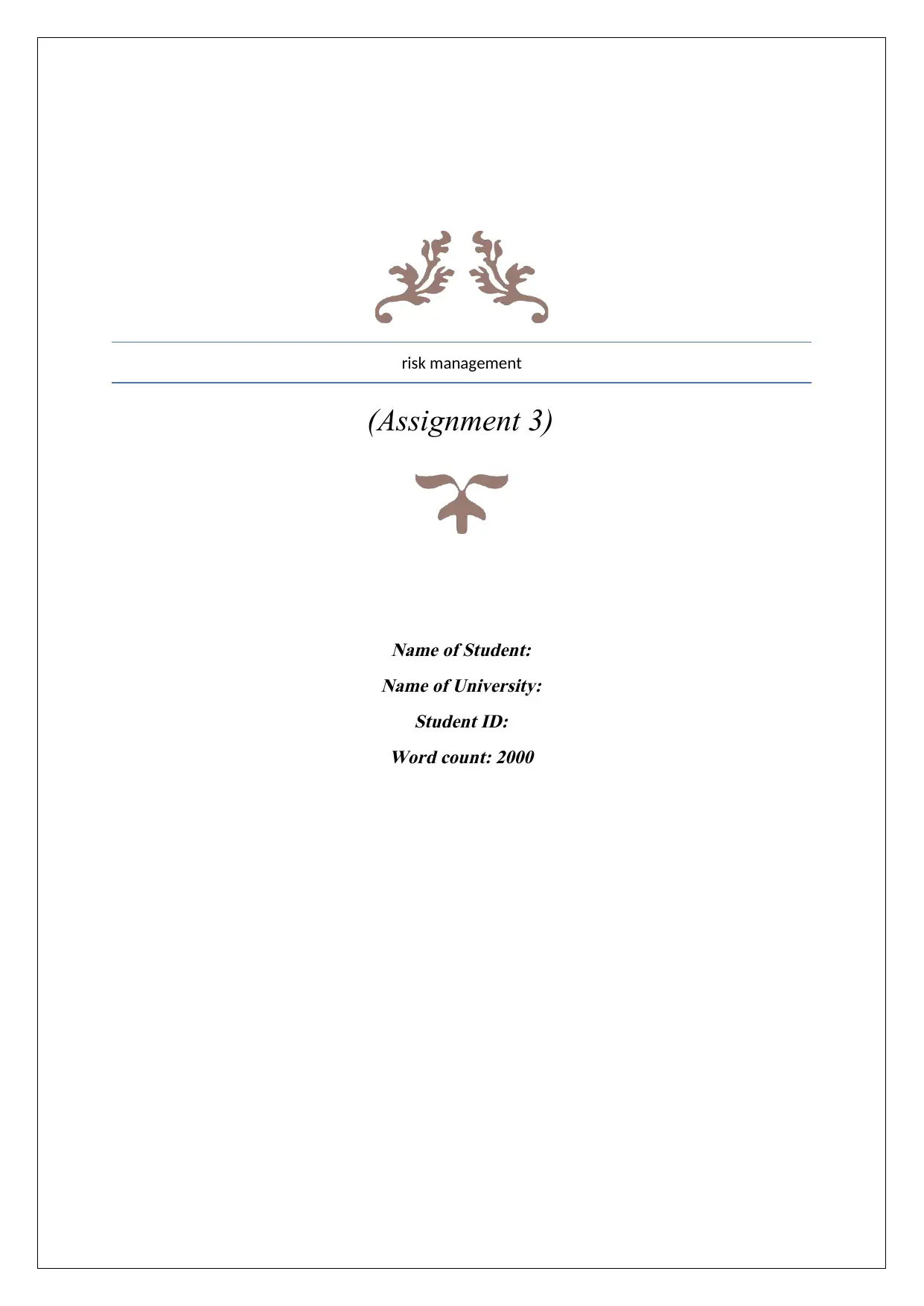
risk management
(Assignment 3)
Name of Student:
Name of University:
Student ID:
Word count: 2000
(Assignment 3)
Name of Student:
Name of University:
Student ID:
Word count: 2000
Paraphrase This Document
Need a fresh take? Get an instant paraphrase of this document with our AI Paraphraser
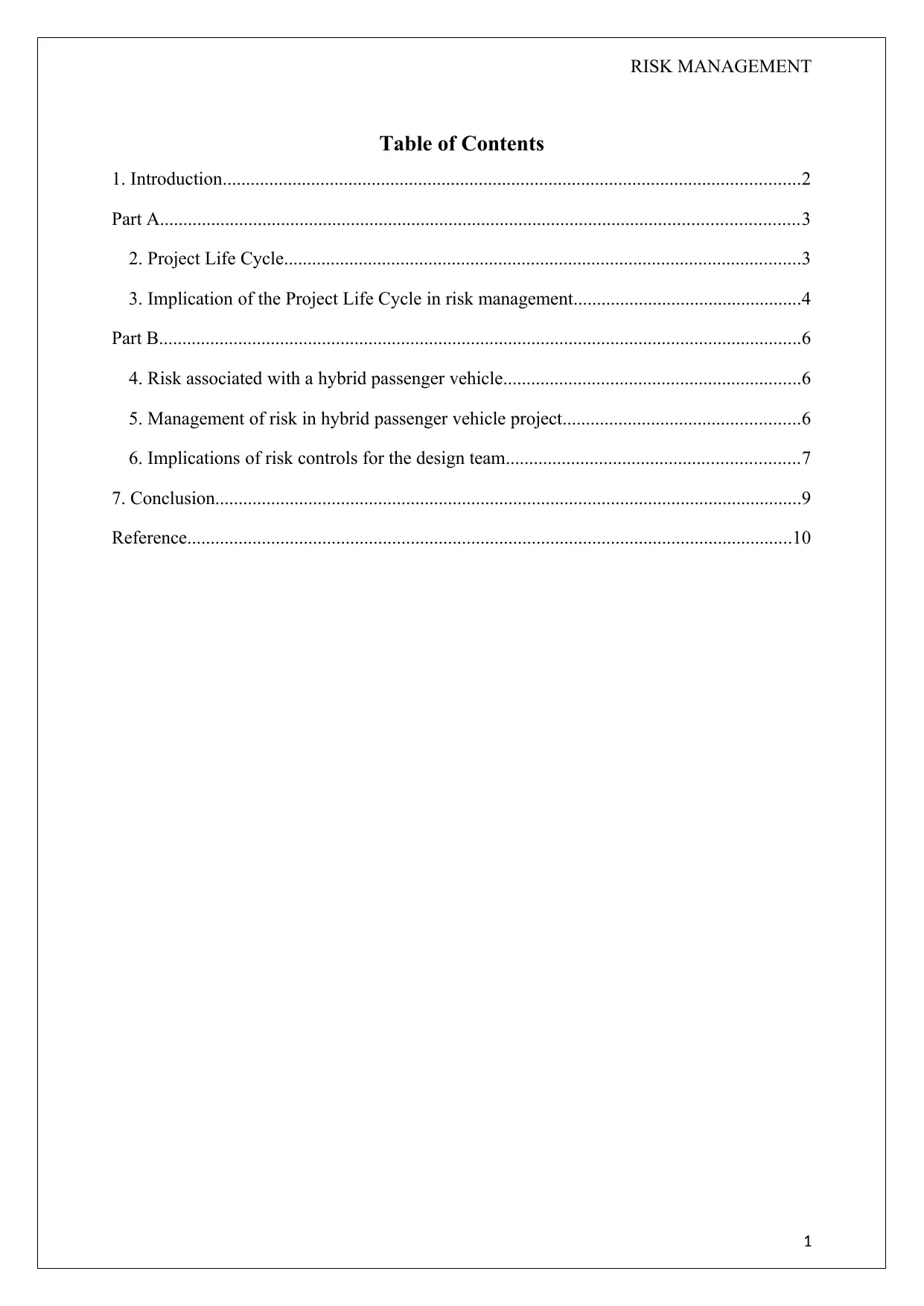
RISK MANAGEMENT
Table of Contents
1. Introduction............................................................................................................................2
Part A.........................................................................................................................................3
2. Project Life Cycle...............................................................................................................3
3. Implication of the Project Life Cycle in risk management.................................................4
Part B..........................................................................................................................................6
4. Risk associated with a hybrid passenger vehicle................................................................6
5. Management of risk in hybrid passenger vehicle project...................................................6
6. Implications of risk controls for the design team...............................................................7
7. Conclusion..............................................................................................................................9
Reference..................................................................................................................................10
1
Table of Contents
1. Introduction............................................................................................................................2
Part A.........................................................................................................................................3
2. Project Life Cycle...............................................................................................................3
3. Implication of the Project Life Cycle in risk management.................................................4
Part B..........................................................................................................................................6
4. Risk associated with a hybrid passenger vehicle................................................................6
5. Management of risk in hybrid passenger vehicle project...................................................6
6. Implications of risk controls for the design team...............................................................7
7. Conclusion..............................................................................................................................9
Reference..................................................................................................................................10
1
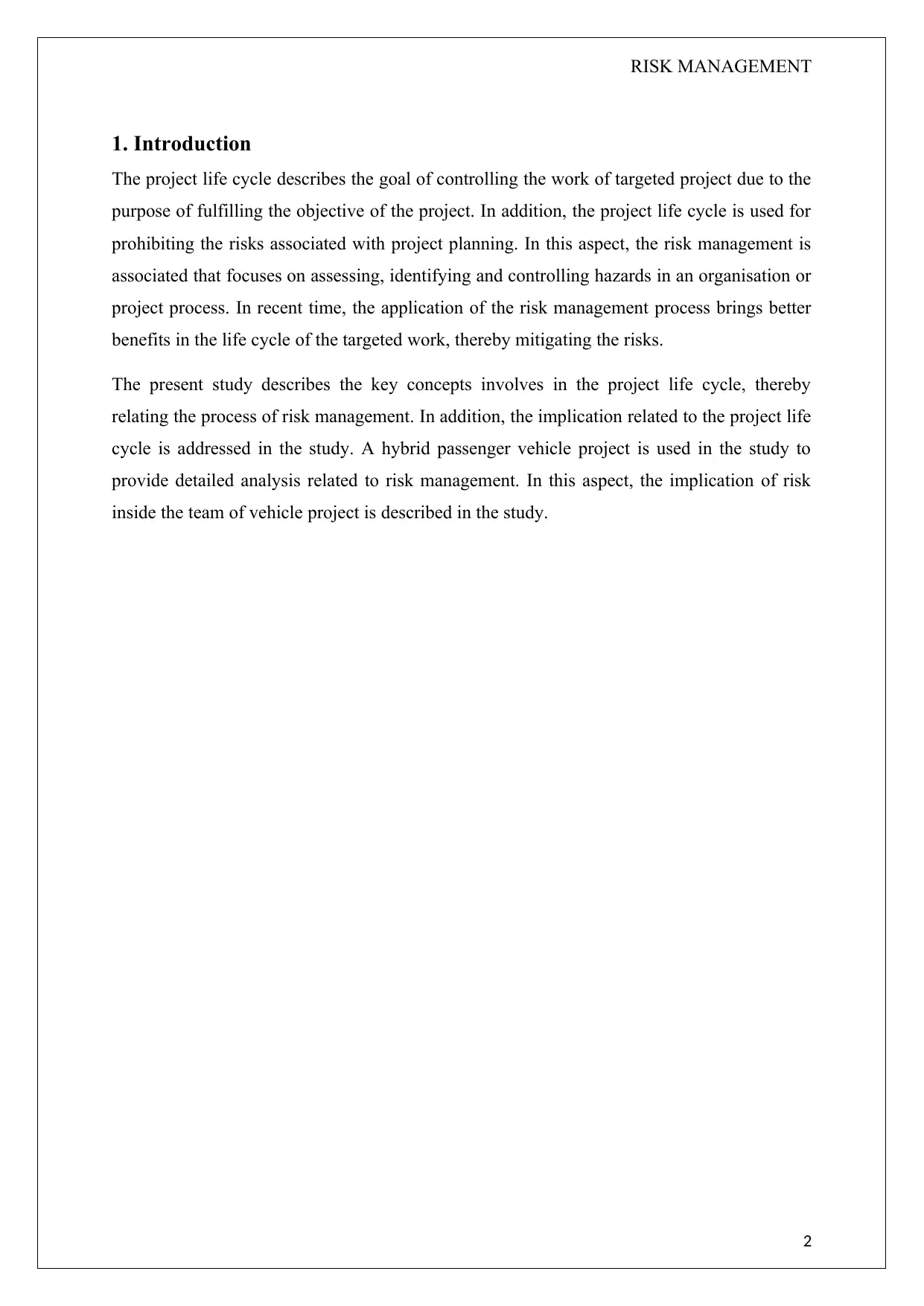
RISK MANAGEMENT
1. Introduction
The project life cycle describes the goal of controlling the work of targeted project due to the
purpose of fulfilling the objective of the project. In addition, the project life cycle is used for
prohibiting the risks associated with project planning. In this aspect, the risk management is
associated that focuses on assessing, identifying and controlling hazards in an organisation or
project process. In recent time, the application of the risk management process brings better
benefits in the life cycle of the targeted work, thereby mitigating the risks.
The present study describes the key concepts involves in the project life cycle, thereby
relating the process of risk management. In addition, the implication related to the project life
cycle is addressed in the study. A hybrid passenger vehicle project is used in the study to
provide detailed analysis related to risk management. In this aspect, the implication of risk
inside the team of vehicle project is described in the study.
2
1. Introduction
The project life cycle describes the goal of controlling the work of targeted project due to the
purpose of fulfilling the objective of the project. In addition, the project life cycle is used for
prohibiting the risks associated with project planning. In this aspect, the risk management is
associated that focuses on assessing, identifying and controlling hazards in an organisation or
project process. In recent time, the application of the risk management process brings better
benefits in the life cycle of the targeted work, thereby mitigating the risks.
The present study describes the key concepts involves in the project life cycle, thereby
relating the process of risk management. In addition, the implication related to the project life
cycle is addressed in the study. A hybrid passenger vehicle project is used in the study to
provide detailed analysis related to risk management. In this aspect, the implication of risk
inside the team of vehicle project is described in the study.
2
⊘ This is a preview!⊘
Do you want full access?
Subscribe today to unlock all pages.

Trusted by 1+ million students worldwide
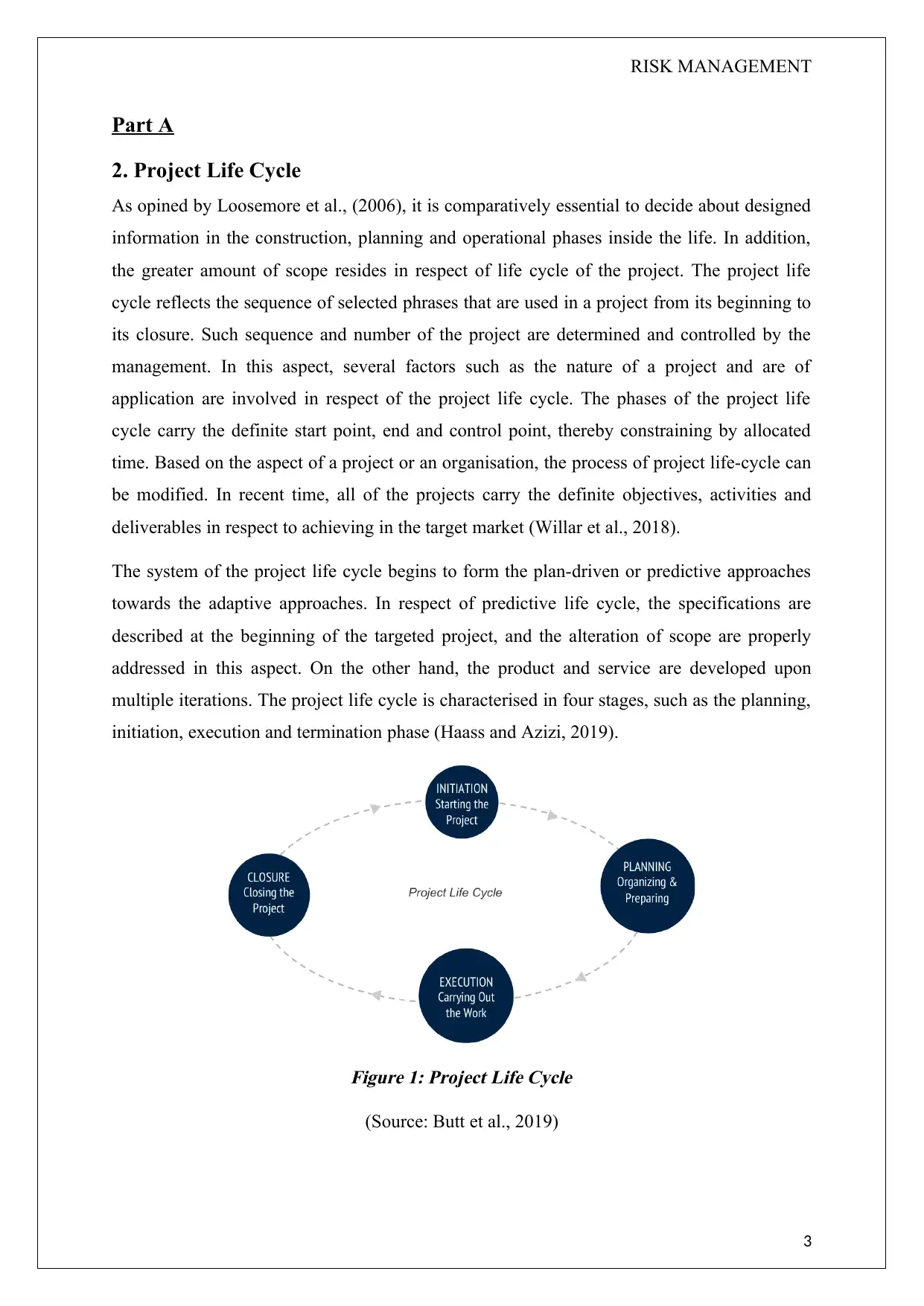
RISK MANAGEMENT
Part A
2. Project Life Cycle
As opined by Loosemore et al., (2006), it is comparatively essential to decide about designed
information in the construction, planning and operational phases inside the life. In addition,
the greater amount of scope resides in respect of life cycle of the project. The project life
cycle reflects the sequence of selected phrases that are used in a project from its beginning to
its closure. Such sequence and number of the project are determined and controlled by the
management. In this aspect, several factors such as the nature of a project and are of
application are involved in respect of the project life cycle. The phases of the project life
cycle carry the definite start point, end and control point, thereby constraining by allocated
time. Based on the aspect of a project or an organisation, the process of project life-cycle can
be modified. In recent time, all of the projects carry the definite objectives, activities and
deliverables in respect to achieving in the target market (Willar et al., 2018).
The system of the project life cycle begins to form the plan-driven or predictive approaches
towards the adaptive approaches. In respect of predictive life cycle, the specifications are
described at the beginning of the targeted project, and the alteration of scope are properly
addressed in this aspect. On the other hand, the product and service are developed upon
multiple iterations. The project life cycle is characterised in four stages, such as the planning,
initiation, execution and termination phase (Haass and Azizi, 2019).
Figure 1: Project Life Cycle
(Source: Butt et al., 2019)
3
Part A
2. Project Life Cycle
As opined by Loosemore et al., (2006), it is comparatively essential to decide about designed
information in the construction, planning and operational phases inside the life. In addition,
the greater amount of scope resides in respect of life cycle of the project. The project life
cycle reflects the sequence of selected phrases that are used in a project from its beginning to
its closure. Such sequence and number of the project are determined and controlled by the
management. In this aspect, several factors such as the nature of a project and are of
application are involved in respect of the project life cycle. The phases of the project life
cycle carry the definite start point, end and control point, thereby constraining by allocated
time. Based on the aspect of a project or an organisation, the process of project life-cycle can
be modified. In recent time, all of the projects carry the definite objectives, activities and
deliverables in respect to achieving in the target market (Willar et al., 2018).
The system of the project life cycle begins to form the plan-driven or predictive approaches
towards the adaptive approaches. In respect of predictive life cycle, the specifications are
described at the beginning of the targeted project, and the alteration of scope are properly
addressed in this aspect. On the other hand, the product and service are developed upon
multiple iterations. The project life cycle is characterised in four stages, such as the planning,
initiation, execution and termination phase (Haass and Azizi, 2019).
Figure 1: Project Life Cycle
(Source: Butt et al., 2019)
3
Paraphrase This Document
Need a fresh take? Get an instant paraphrase of this document with our AI Paraphraser
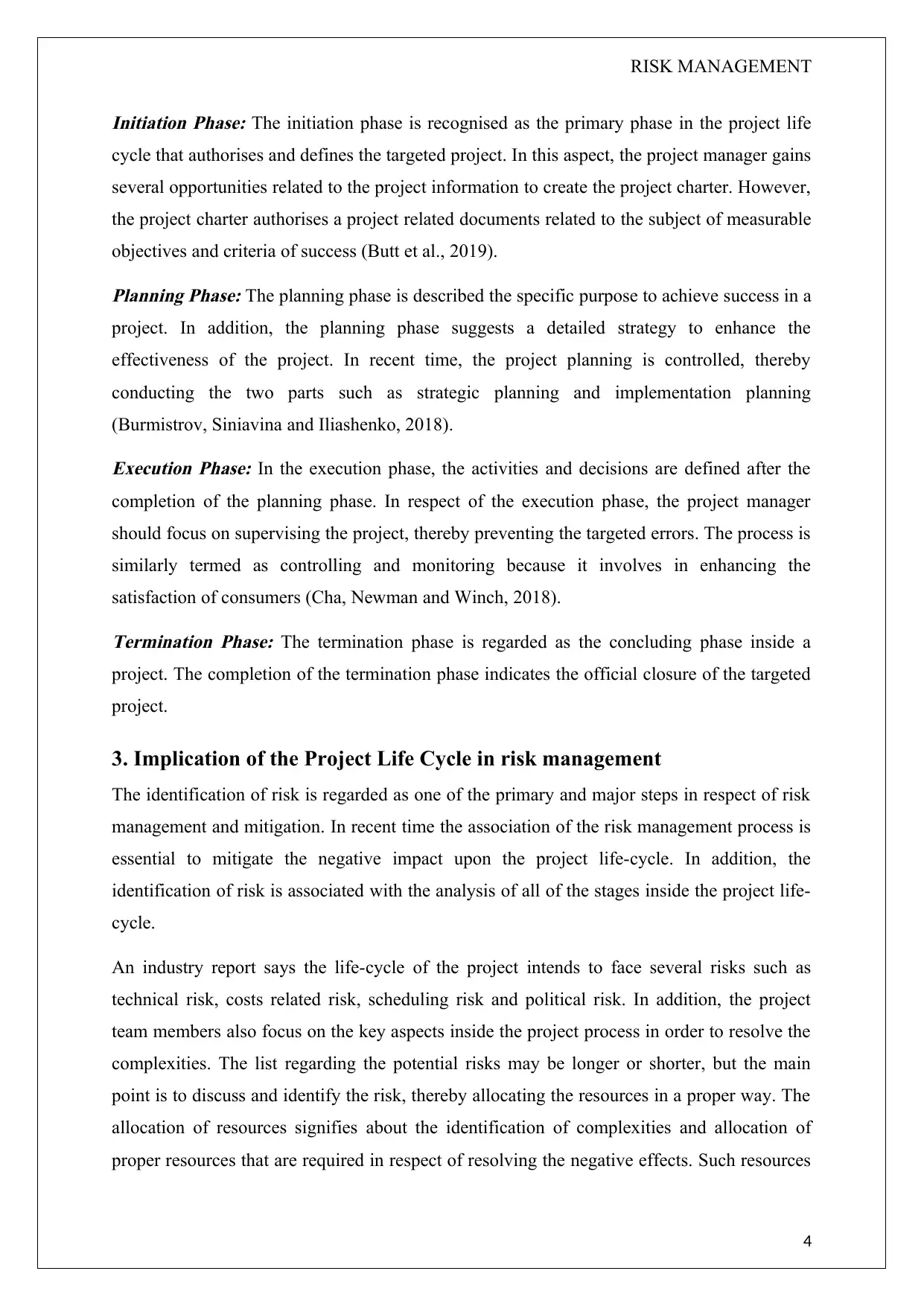
RISK MANAGEMENT
Initiation Phase: The initiation phase is recognised as the primary phase in the project life
cycle that authorises and defines the targeted project. In this aspect, the project manager gains
several opportunities related to the project information to create the project charter. However,
the project charter authorises a project related documents related to the subject of measurable
objectives and criteria of success (Butt et al., 2019).
Planning Phase: The planning phase is described the specific purpose to achieve success in a
project. In addition, the planning phase suggests a detailed strategy to enhance the
effectiveness of the project. In recent time, the project planning is controlled, thereby
conducting the two parts such as strategic planning and implementation planning
(Burmistrov, Siniavina and Iliashenko, 2018).
Execution Phase: In the execution phase, the activities and decisions are defined after the
completion of the planning phase. In respect of the execution phase, the project manager
should focus on supervising the project, thereby preventing the targeted errors. The process is
similarly termed as controlling and monitoring because it involves in enhancing the
satisfaction of consumers (Cha, Newman and Winch, 2018).
Termination Phase: The termination phase is regarded as the concluding phase inside a
project. The completion of the termination phase indicates the official closure of the targeted
project.
3. Implication of the Project Life Cycle in risk management
The identification of risk is regarded as one of the primary and major steps in respect of risk
management and mitigation. In recent time the association of the risk management process is
essential to mitigate the negative impact upon the project life-cycle. In addition, the
identification of risk is associated with the analysis of all of the stages inside the project life-
cycle.
An industry report says the life-cycle of the project intends to face several risks such as
technical risk, costs related risk, scheduling risk and political risk. In addition, the project
team members also focus on the key aspects inside the project process in order to resolve the
complexities. The list regarding the potential risks may be longer or shorter, but the main
point is to discuss and identify the risk, thereby allocating the resources in a proper way. The
allocation of resources signifies about the identification of complexities and allocation of
proper resources that are required in respect of resolving the negative effects. Such resources
4
Initiation Phase: The initiation phase is recognised as the primary phase in the project life
cycle that authorises and defines the targeted project. In this aspect, the project manager gains
several opportunities related to the project information to create the project charter. However,
the project charter authorises a project related documents related to the subject of measurable
objectives and criteria of success (Butt et al., 2019).
Planning Phase: The planning phase is described the specific purpose to achieve success in a
project. In addition, the planning phase suggests a detailed strategy to enhance the
effectiveness of the project. In recent time, the project planning is controlled, thereby
conducting the two parts such as strategic planning and implementation planning
(Burmistrov, Siniavina and Iliashenko, 2018).
Execution Phase: In the execution phase, the activities and decisions are defined after the
completion of the planning phase. In respect of the execution phase, the project manager
should focus on supervising the project, thereby preventing the targeted errors. The process is
similarly termed as controlling and monitoring because it involves in enhancing the
satisfaction of consumers (Cha, Newman and Winch, 2018).
Termination Phase: The termination phase is regarded as the concluding phase inside a
project. The completion of the termination phase indicates the official closure of the targeted
project.
3. Implication of the Project Life Cycle in risk management
The identification of risk is regarded as one of the primary and major steps in respect of risk
management and mitigation. In recent time the association of the risk management process is
essential to mitigate the negative impact upon the project life-cycle. In addition, the
identification of risk is associated with the analysis of all of the stages inside the project life-
cycle.
An industry report says the life-cycle of the project intends to face several risks such as
technical risk, costs related risk, scheduling risk and political risk. In addition, the project
team members also focus on the key aspects inside the project process in order to resolve the
complexities. The list regarding the potential risks may be longer or shorter, but the main
point is to discuss and identify the risk, thereby allocating the resources in a proper way. The
allocation of resources signifies about the identification of complexities and allocation of
proper resources that are required in respect of resolving the negative effects. Such resources
4
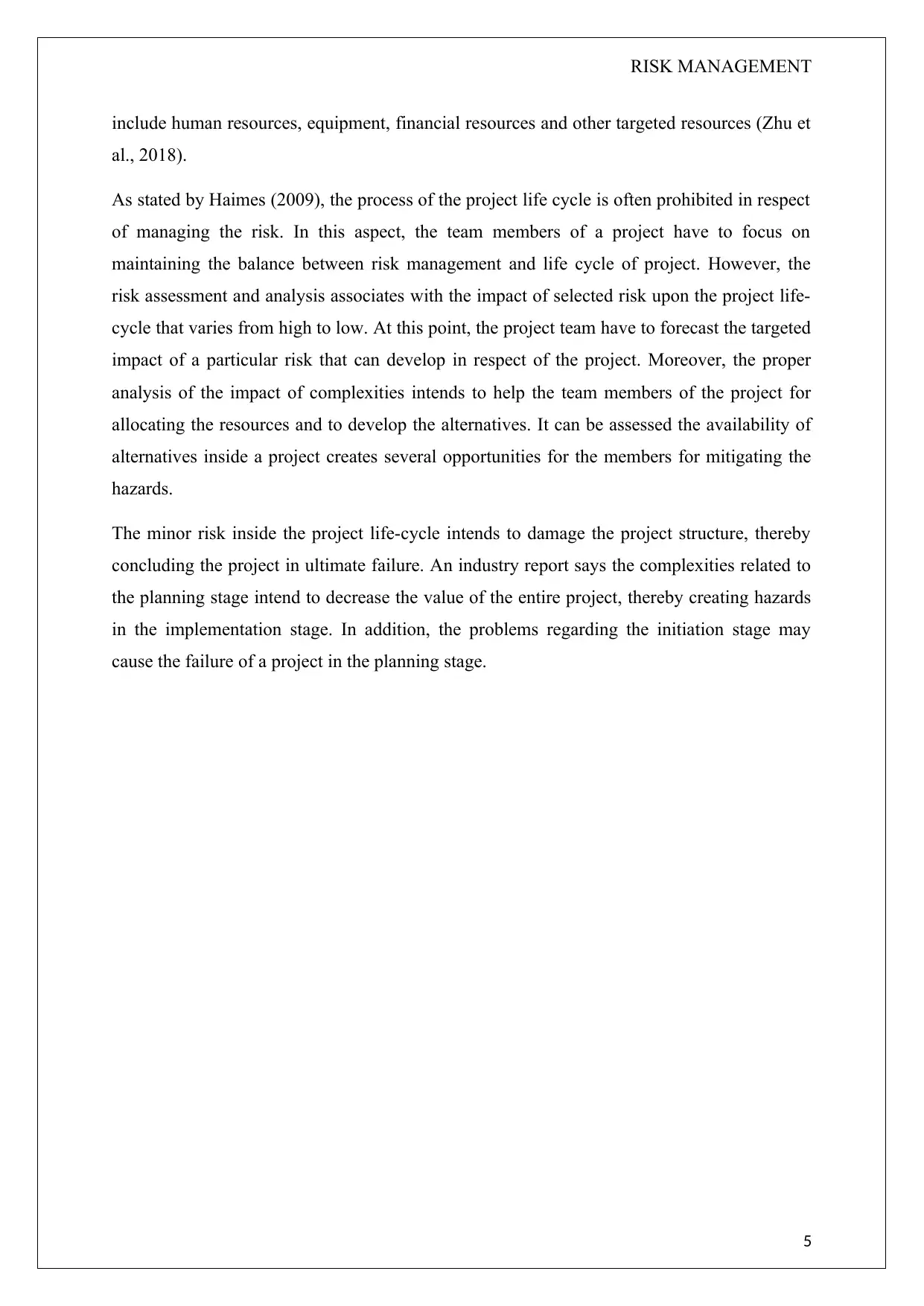
RISK MANAGEMENT
include human resources, equipment, financial resources and other targeted resources (Zhu et
al., 2018).
As stated by Haimes (2009), the process of the project life cycle is often prohibited in respect
of managing the risk. In this aspect, the team members of a project have to focus on
maintaining the balance between risk management and life cycle of project. However, the
risk assessment and analysis associates with the impact of selected risk upon the project life-
cycle that varies from high to low. At this point, the project team have to forecast the targeted
impact of a particular risk that can develop in respect of the project. Moreover, the proper
analysis of the impact of complexities intends to help the team members of the project for
allocating the resources and to develop the alternatives. It can be assessed the availability of
alternatives inside a project creates several opportunities for the members for mitigating the
hazards.
The minor risk inside the project life-cycle intends to damage the project structure, thereby
concluding the project in ultimate failure. An industry report says the complexities related to
the planning stage intend to decrease the value of the entire project, thereby creating hazards
in the implementation stage. In addition, the problems regarding the initiation stage may
cause the failure of a project in the planning stage.
5
include human resources, equipment, financial resources and other targeted resources (Zhu et
al., 2018).
As stated by Haimes (2009), the process of the project life cycle is often prohibited in respect
of managing the risk. In this aspect, the team members of a project have to focus on
maintaining the balance between risk management and life cycle of project. However, the
risk assessment and analysis associates with the impact of selected risk upon the project life-
cycle that varies from high to low. At this point, the project team have to forecast the targeted
impact of a particular risk that can develop in respect of the project. Moreover, the proper
analysis of the impact of complexities intends to help the team members of the project for
allocating the resources and to develop the alternatives. It can be assessed the availability of
alternatives inside a project creates several opportunities for the members for mitigating the
hazards.
The minor risk inside the project life-cycle intends to damage the project structure, thereby
concluding the project in ultimate failure. An industry report says the complexities related to
the planning stage intend to decrease the value of the entire project, thereby creating hazards
in the implementation stage. In addition, the problems regarding the initiation stage may
cause the failure of a project in the planning stage.
5
⊘ This is a preview!⊘
Do you want full access?
Subscribe today to unlock all pages.

Trusted by 1+ million students worldwide
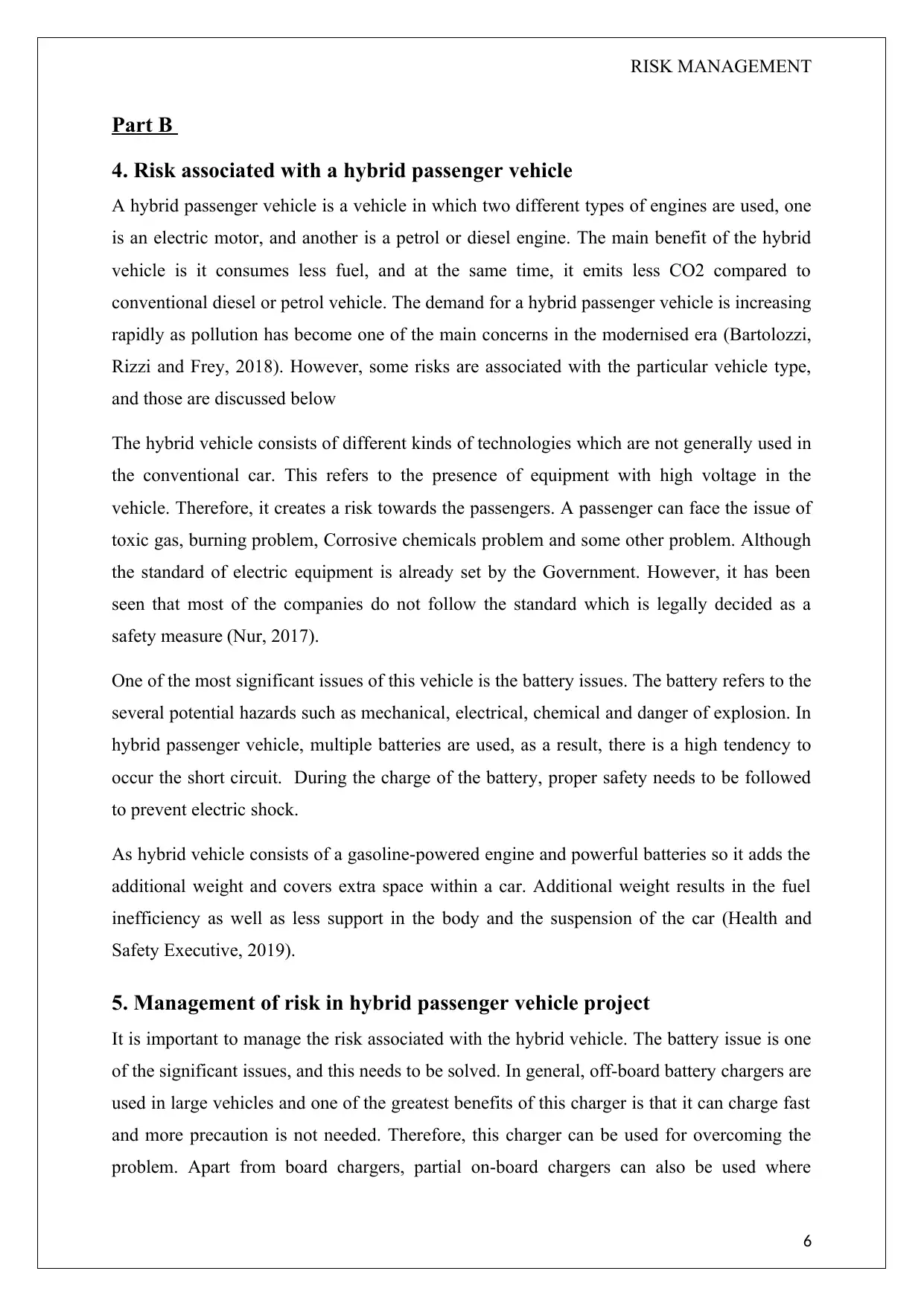
RISK MANAGEMENT
Part B
4. Risk associated with a hybrid passenger vehicle
A hybrid passenger vehicle is a vehicle in which two different types of engines are used, one
is an electric motor, and another is a petrol or diesel engine. The main benefit of the hybrid
vehicle is it consumes less fuel, and at the same time, it emits less CO2 compared to
conventional diesel or petrol vehicle. The demand for a hybrid passenger vehicle is increasing
rapidly as pollution has become one of the main concerns in the modernised era (Bartolozzi,
Rizzi and Frey, 2018). However, some risks are associated with the particular vehicle type,
and those are discussed below
The hybrid vehicle consists of different kinds of technologies which are not generally used in
the conventional car. This refers to the presence of equipment with high voltage in the
vehicle. Therefore, it creates a risk towards the passengers. A passenger can face the issue of
toxic gas, burning problem, Corrosive chemicals problem and some other problem. Although
the standard of electric equipment is already set by the Government. However, it has been
seen that most of the companies do not follow the standard which is legally decided as a
safety measure (Nur, 2017).
One of the most significant issues of this vehicle is the battery issues. The battery refers to the
several potential hazards such as mechanical, electrical, chemical and danger of explosion. In
hybrid passenger vehicle, multiple batteries are used, as a result, there is a high tendency to
occur the short circuit. During the charge of the battery, proper safety needs to be followed
to prevent electric shock.
As hybrid vehicle consists of a gasoline-powered engine and powerful batteries so it adds the
additional weight and covers extra space within a car. Additional weight results in the fuel
inefficiency as well as less support in the body and the suspension of the car (Health and
Safety Executive, 2019).
5. Management of risk in hybrid passenger vehicle project
It is important to manage the risk associated with the hybrid vehicle. The battery issue is one
of the significant issues, and this needs to be solved. In general, off-board battery chargers are
used in large vehicles and one of the greatest benefits of this charger is that it can charge fast
and more precaution is not needed. Therefore, this charger can be used for overcoming the
problem. Apart from board chargers, partial on-board chargers can also be used where
6
Part B
4. Risk associated with a hybrid passenger vehicle
A hybrid passenger vehicle is a vehicle in which two different types of engines are used, one
is an electric motor, and another is a petrol or diesel engine. The main benefit of the hybrid
vehicle is it consumes less fuel, and at the same time, it emits less CO2 compared to
conventional diesel or petrol vehicle. The demand for a hybrid passenger vehicle is increasing
rapidly as pollution has become one of the main concerns in the modernised era (Bartolozzi,
Rizzi and Frey, 2018). However, some risks are associated with the particular vehicle type,
and those are discussed below
The hybrid vehicle consists of different kinds of technologies which are not generally used in
the conventional car. This refers to the presence of equipment with high voltage in the
vehicle. Therefore, it creates a risk towards the passengers. A passenger can face the issue of
toxic gas, burning problem, Corrosive chemicals problem and some other problem. Although
the standard of electric equipment is already set by the Government. However, it has been
seen that most of the companies do not follow the standard which is legally decided as a
safety measure (Nur, 2017).
One of the most significant issues of this vehicle is the battery issues. The battery refers to the
several potential hazards such as mechanical, electrical, chemical and danger of explosion. In
hybrid passenger vehicle, multiple batteries are used, as a result, there is a high tendency to
occur the short circuit. During the charge of the battery, proper safety needs to be followed
to prevent electric shock.
As hybrid vehicle consists of a gasoline-powered engine and powerful batteries so it adds the
additional weight and covers extra space within a car. Additional weight results in the fuel
inefficiency as well as less support in the body and the suspension of the car (Health and
Safety Executive, 2019).
5. Management of risk in hybrid passenger vehicle project
It is important to manage the risk associated with the hybrid vehicle. The battery issue is one
of the significant issues, and this needs to be solved. In general, off-board battery chargers are
used in large vehicles and one of the greatest benefits of this charger is that it can charge fast
and more precaution is not needed. Therefore, this charger can be used for overcoming the
problem. Apart from board chargers, partial on-board chargers can also be used where
6
Paraphrase This Document
Need a fresh take? Get an instant paraphrase of this document with our AI Paraphraser
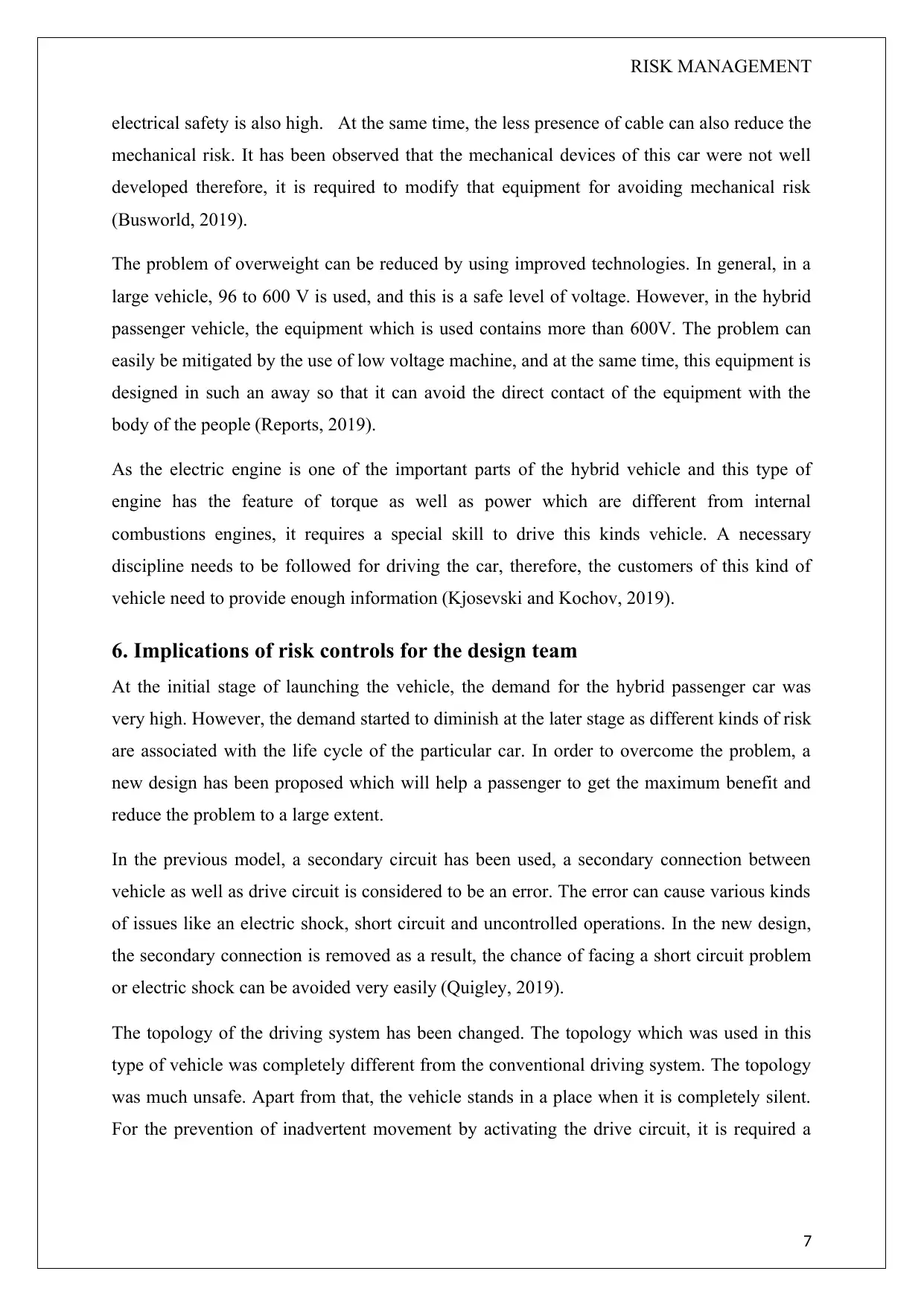
RISK MANAGEMENT
electrical safety is also high. At the same time, the less presence of cable can also reduce the
mechanical risk. It has been observed that the mechanical devices of this car were not well
developed therefore, it is required to modify that equipment for avoiding mechanical risk
(Busworld, 2019).
The problem of overweight can be reduced by using improved technologies. In general, in a
large vehicle, 96 to 600 V is used, and this is a safe level of voltage. However, in the hybrid
passenger vehicle, the equipment which is used contains more than 600V. The problem can
easily be mitigated by the use of low voltage machine, and at the same time, this equipment is
designed in such an away so that it can avoid the direct contact of the equipment with the
body of the people (Reports, 2019).
As the electric engine is one of the important parts of the hybrid vehicle and this type of
engine has the feature of torque as well as power which are different from internal
combustions engines, it requires a special skill to drive this kinds vehicle. A necessary
discipline needs to be followed for driving the car, therefore, the customers of this kind of
vehicle need to provide enough information (Kjosevski and Kochov, 2019).
6. Implications of risk controls for the design team
At the initial stage of launching the vehicle, the demand for the hybrid passenger car was
very high. However, the demand started to diminish at the later stage as different kinds of risk
are associated with the life cycle of the particular car. In order to overcome the problem, a
new design has been proposed which will help a passenger to get the maximum benefit and
reduce the problem to a large extent.
In the previous model, a secondary circuit has been used, a secondary connection between
vehicle as well as drive circuit is considered to be an error. The error can cause various kinds
of issues like an electric shock, short circuit and uncontrolled operations. In the new design,
the secondary connection is removed as a result, the chance of facing a short circuit problem
or electric shock can be avoided very easily (Quigley, 2019).
The topology of the driving system has been changed. The topology which was used in this
type of vehicle was completely different from the conventional driving system. The topology
was much unsafe. Apart from that, the vehicle stands in a place when it is completely silent.
For the prevention of inadvertent movement by activating the drive circuit, it is required a
7
electrical safety is also high. At the same time, the less presence of cable can also reduce the
mechanical risk. It has been observed that the mechanical devices of this car were not well
developed therefore, it is required to modify that equipment for avoiding mechanical risk
(Busworld, 2019).
The problem of overweight can be reduced by using improved technologies. In general, in a
large vehicle, 96 to 600 V is used, and this is a safe level of voltage. However, in the hybrid
passenger vehicle, the equipment which is used contains more than 600V. The problem can
easily be mitigated by the use of low voltage machine, and at the same time, this equipment is
designed in such an away so that it can avoid the direct contact of the equipment with the
body of the people (Reports, 2019).
As the electric engine is one of the important parts of the hybrid vehicle and this type of
engine has the feature of torque as well as power which are different from internal
combustions engines, it requires a special skill to drive this kinds vehicle. A necessary
discipline needs to be followed for driving the car, therefore, the customers of this kind of
vehicle need to provide enough information (Kjosevski and Kochov, 2019).
6. Implications of risk controls for the design team
At the initial stage of launching the vehicle, the demand for the hybrid passenger car was
very high. However, the demand started to diminish at the later stage as different kinds of risk
are associated with the life cycle of the particular car. In order to overcome the problem, a
new design has been proposed which will help a passenger to get the maximum benefit and
reduce the problem to a large extent.
In the previous model, a secondary circuit has been used, a secondary connection between
vehicle as well as drive circuit is considered to be an error. The error can cause various kinds
of issues like an electric shock, short circuit and uncontrolled operations. In the new design,
the secondary connection is removed as a result, the chance of facing a short circuit problem
or electric shock can be avoided very easily (Quigley, 2019).
The topology of the driving system has been changed. The topology which was used in this
type of vehicle was completely different from the conventional driving system. The topology
was much unsafe. Apart from that, the vehicle stands in a place when it is completely silent.
For the prevention of inadvertent movement by activating the drive circuit, it is required a
7
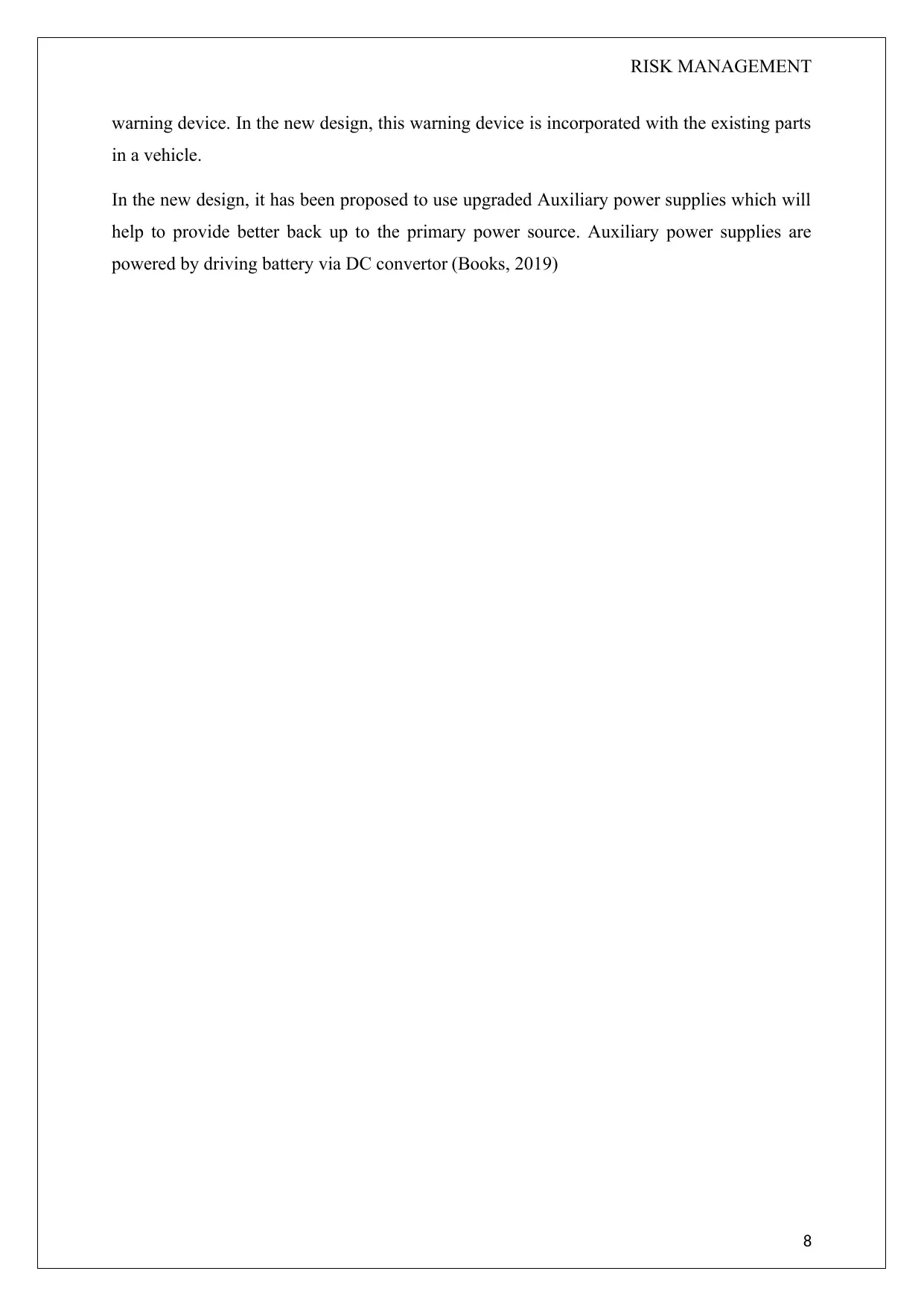
RISK MANAGEMENT
warning device. In the new design, this warning device is incorporated with the existing parts
in a vehicle.
In the new design, it has been proposed to use upgraded Auxiliary power supplies which will
help to provide better back up to the primary power source. Auxiliary power supplies are
powered by driving battery via DC convertor (Books, 2019)
8
warning device. In the new design, this warning device is incorporated with the existing parts
in a vehicle.
In the new design, it has been proposed to use upgraded Auxiliary power supplies which will
help to provide better back up to the primary power source. Auxiliary power supplies are
powered by driving battery via DC convertor (Books, 2019)
8
⊘ This is a preview!⊘
Do you want full access?
Subscribe today to unlock all pages.

Trusted by 1+ million students worldwide
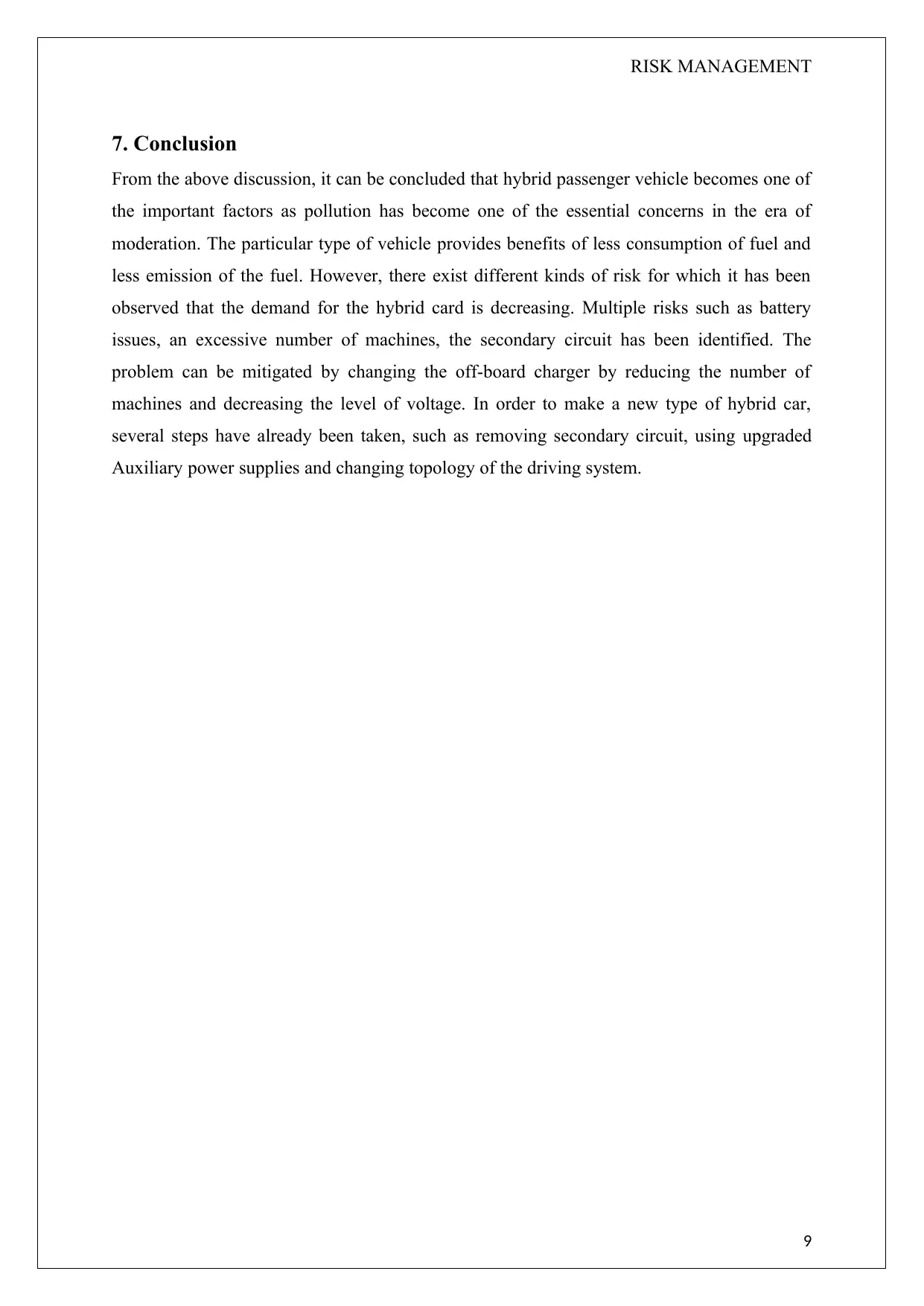
RISK MANAGEMENT
7. Conclusion
From the above discussion, it can be concluded that hybrid passenger vehicle becomes one of
the important factors as pollution has become one of the essential concerns in the era of
moderation. The particular type of vehicle provides benefits of less consumption of fuel and
less emission of the fuel. However, there exist different kinds of risk for which it has been
observed that the demand for the hybrid card is decreasing. Multiple risks such as battery
issues, an excessive number of machines, the secondary circuit has been identified. The
problem can be mitigated by changing the off-board charger by reducing the number of
machines and decreasing the level of voltage. In order to make a new type of hybrid car,
several steps have already been taken, such as removing secondary circuit, using upgraded
Auxiliary power supplies and changing topology of the driving system.
9
7. Conclusion
From the above discussion, it can be concluded that hybrid passenger vehicle becomes one of
the important factors as pollution has become one of the essential concerns in the era of
moderation. The particular type of vehicle provides benefits of less consumption of fuel and
less emission of the fuel. However, there exist different kinds of risk for which it has been
observed that the demand for the hybrid card is decreasing. Multiple risks such as battery
issues, an excessive number of machines, the secondary circuit has been identified. The
problem can be mitigated by changing the off-board charger by reducing the number of
machines and decreasing the level of voltage. In order to make a new type of hybrid car,
several steps have already been taken, such as removing secondary circuit, using upgraded
Auxiliary power supplies and changing topology of the driving system.
9
Paraphrase This Document
Need a fresh take? Get an instant paraphrase of this document with our AI Paraphraser
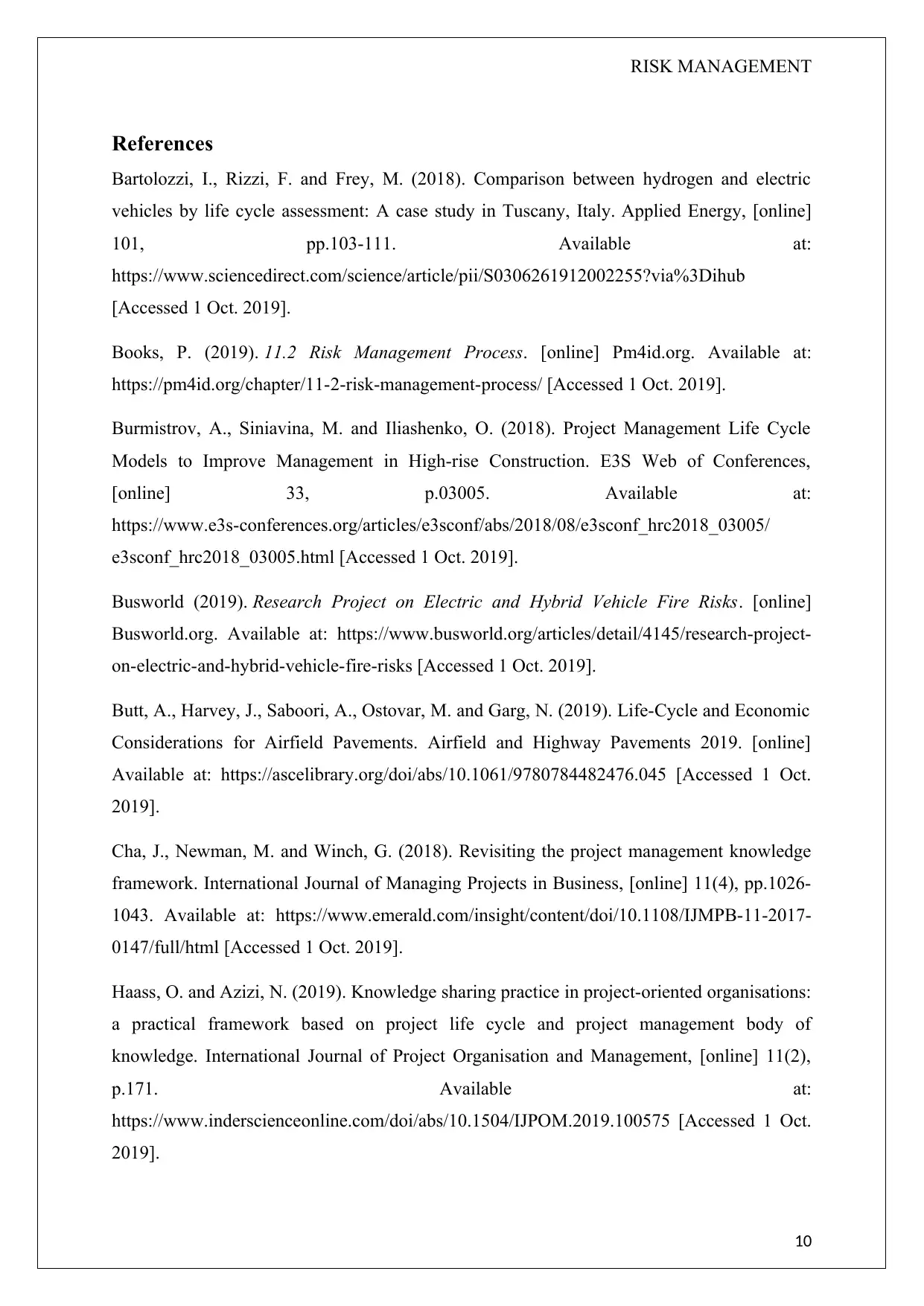
RISK MANAGEMENT
References
Bartolozzi, I., Rizzi, F. and Frey, M. (2018). Comparison between hydrogen and electric
vehicles by life cycle assessment: A case study in Tuscany, Italy. Applied Energy, [online]
101, pp.103-111. Available at:
https://www.sciencedirect.com/science/article/pii/S0306261912002255?via%3Dihub
[Accessed 1 Oct. 2019].
Books, P. (2019). 11.2 Risk Management Process. [online] Pm4id.org. Available at:
https://pm4id.org/chapter/11-2-risk-management-process/ [Accessed 1 Oct. 2019].
Burmistrov, A., Siniavina, M. and Iliashenko, O. (2018). Project Management Life Cycle
Models to Improve Management in High-rise Construction. E3S Web of Conferences,
[online] 33, p.03005. Available at:
https://www.e3s-conferences.org/articles/e3sconf/abs/2018/08/e3sconf_hrc2018_03005/
e3sconf_hrc2018_03005.html [Accessed 1 Oct. 2019].
Busworld (2019). Research Project on Electric and Hybrid Vehicle Fire Risks. [online]
Busworld.org. Available at: https://www.busworld.org/articles/detail/4145/research-project-
on-electric-and-hybrid-vehicle-fire-risks [Accessed 1 Oct. 2019].
Butt, A., Harvey, J., Saboori, A., Ostovar, M. and Garg, N. (2019). Life-Cycle and Economic
Considerations for Airfield Pavements. Airfield and Highway Pavements 2019. [online]
Available at: https://ascelibrary.org/doi/abs/10.1061/9780784482476.045 [Accessed 1 Oct.
2019].
Cha, J., Newman, M. and Winch, G. (2018). Revisiting the project management knowledge
framework. International Journal of Managing Projects in Business, [online] 11(4), pp.1026-
1043. Available at: https://www.emerald.com/insight/content/doi/10.1108/IJMPB-11-2017-
0147/full/html [Accessed 1 Oct. 2019].
Haass, O. and Azizi, N. (2019). Knowledge sharing practice in project-oriented organisations:
a practical framework based on project life cycle and project management body of
knowledge. International Journal of Project Organisation and Management, [online] 11(2),
p.171. Available at:
https://www.inderscienceonline.com/doi/abs/10.1504/IJPOM.2019.100575 [Accessed 1 Oct.
2019].
10
References
Bartolozzi, I., Rizzi, F. and Frey, M. (2018). Comparison between hydrogen and electric
vehicles by life cycle assessment: A case study in Tuscany, Italy. Applied Energy, [online]
101, pp.103-111. Available at:
https://www.sciencedirect.com/science/article/pii/S0306261912002255?via%3Dihub
[Accessed 1 Oct. 2019].
Books, P. (2019). 11.2 Risk Management Process. [online] Pm4id.org. Available at:
https://pm4id.org/chapter/11-2-risk-management-process/ [Accessed 1 Oct. 2019].
Burmistrov, A., Siniavina, M. and Iliashenko, O. (2018). Project Management Life Cycle
Models to Improve Management in High-rise Construction. E3S Web of Conferences,
[online] 33, p.03005. Available at:
https://www.e3s-conferences.org/articles/e3sconf/abs/2018/08/e3sconf_hrc2018_03005/
e3sconf_hrc2018_03005.html [Accessed 1 Oct. 2019].
Busworld (2019). Research Project on Electric and Hybrid Vehicle Fire Risks. [online]
Busworld.org. Available at: https://www.busworld.org/articles/detail/4145/research-project-
on-electric-and-hybrid-vehicle-fire-risks [Accessed 1 Oct. 2019].
Butt, A., Harvey, J., Saboori, A., Ostovar, M. and Garg, N. (2019). Life-Cycle and Economic
Considerations for Airfield Pavements. Airfield and Highway Pavements 2019. [online]
Available at: https://ascelibrary.org/doi/abs/10.1061/9780784482476.045 [Accessed 1 Oct.
2019].
Cha, J., Newman, M. and Winch, G. (2018). Revisiting the project management knowledge
framework. International Journal of Managing Projects in Business, [online] 11(4), pp.1026-
1043. Available at: https://www.emerald.com/insight/content/doi/10.1108/IJMPB-11-2017-
0147/full/html [Accessed 1 Oct. 2019].
Haass, O. and Azizi, N. (2019). Knowledge sharing practice in project-oriented organisations:
a practical framework based on project life cycle and project management body of
knowledge. International Journal of Project Organisation and Management, [online] 11(2),
p.171. Available at:
https://www.inderscienceonline.com/doi/abs/10.1504/IJPOM.2019.100575 [Accessed 1 Oct.
2019].
10
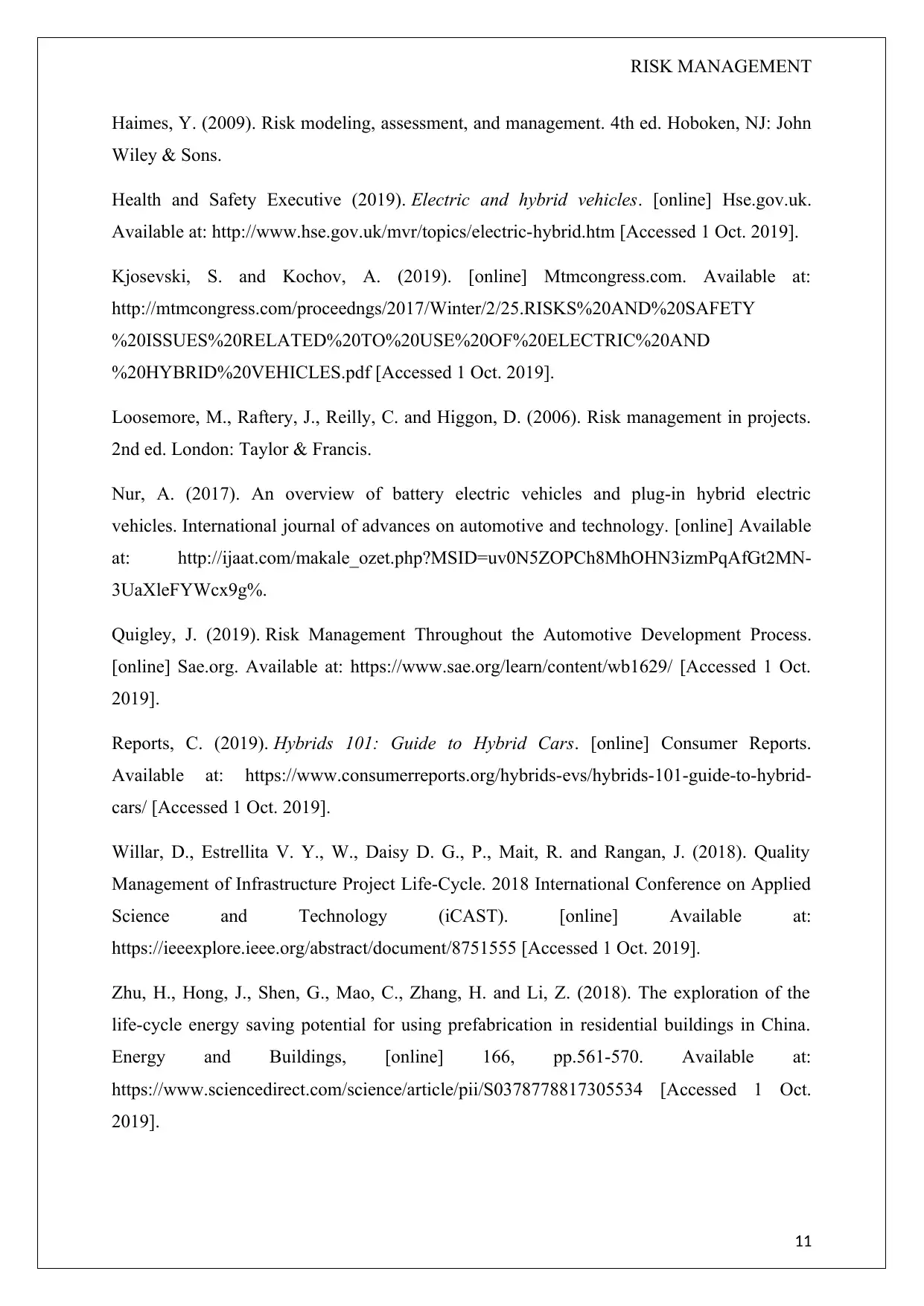
RISK MANAGEMENT
Haimes, Y. (2009). Risk modeling, assessment, and management. 4th ed. Hoboken, NJ: John
Wiley & Sons.
Health and Safety Executive (2019). Electric and hybrid vehicles. [online] Hse.gov.uk.
Available at: http://www.hse.gov.uk/mvr/topics/electric-hybrid.htm [Accessed 1 Oct. 2019].
Kjosevski, S. and Kochov, A. (2019). [online] Mtmcongress.com. Available at:
http://mtmcongress.com/proceedngs/2017/Winter/2/25.RISKS%20AND%20SAFETY
%20ISSUES%20RELATED%20TO%20USE%20OF%20ELECTRIC%20AND
%20HYBRID%20VEHICLES.pdf [Accessed 1 Oct. 2019].
Loosemore, M., Raftery, J., Reilly, C. and Higgon, D. (2006). Risk management in projects.
2nd ed. London: Taylor & Francis.
Nur, A. (2017). An overview of battery electric vehicles and plug-in hybrid electric
vehicles. International journal of advances on automotive and technology. [online] Available
at: http://ijaat.com/makale_ozet.php?MSID=uv0N5ZOPCh8MhOHN3izmPqAfGt2MN-
3UaXleFYWcx9g%.
Quigley, J. (2019). Risk Management Throughout the Automotive Development Process.
[online] Sae.org. Available at: https://www.sae.org/learn/content/wb1629/ [Accessed 1 Oct.
2019].
Reports, C. (2019). Hybrids 101: Guide to Hybrid Cars. [online] Consumer Reports.
Available at: https://www.consumerreports.org/hybrids-evs/hybrids-101-guide-to-hybrid-
cars/ [Accessed 1 Oct. 2019].
Willar, D., Estrellita V. Y., W., Daisy D. G., P., Mait, R. and Rangan, J. (2018). Quality
Management of Infrastructure Project Life-Cycle. 2018 International Conference on Applied
Science and Technology (iCAST). [online] Available at:
https://ieeexplore.ieee.org/abstract/document/8751555 [Accessed 1 Oct. 2019].
Zhu, H., Hong, J., Shen, G., Mao, C., Zhang, H. and Li, Z. (2018). The exploration of the
life-cycle energy saving potential for using prefabrication in residential buildings in China.
Energy and Buildings, [online] 166, pp.561-570. Available at:
https://www.sciencedirect.com/science/article/pii/S0378778817305534 [Accessed 1 Oct.
2019].
11
Haimes, Y. (2009). Risk modeling, assessment, and management. 4th ed. Hoboken, NJ: John
Wiley & Sons.
Health and Safety Executive (2019). Electric and hybrid vehicles. [online] Hse.gov.uk.
Available at: http://www.hse.gov.uk/mvr/topics/electric-hybrid.htm [Accessed 1 Oct. 2019].
Kjosevski, S. and Kochov, A. (2019). [online] Mtmcongress.com. Available at:
http://mtmcongress.com/proceedngs/2017/Winter/2/25.RISKS%20AND%20SAFETY
%20ISSUES%20RELATED%20TO%20USE%20OF%20ELECTRIC%20AND
%20HYBRID%20VEHICLES.pdf [Accessed 1 Oct. 2019].
Loosemore, M., Raftery, J., Reilly, C. and Higgon, D. (2006). Risk management in projects.
2nd ed. London: Taylor & Francis.
Nur, A. (2017). An overview of battery electric vehicles and plug-in hybrid electric
vehicles. International journal of advances on automotive and technology. [online] Available
at: http://ijaat.com/makale_ozet.php?MSID=uv0N5ZOPCh8MhOHN3izmPqAfGt2MN-
3UaXleFYWcx9g%.
Quigley, J. (2019). Risk Management Throughout the Automotive Development Process.
[online] Sae.org. Available at: https://www.sae.org/learn/content/wb1629/ [Accessed 1 Oct.
2019].
Reports, C. (2019). Hybrids 101: Guide to Hybrid Cars. [online] Consumer Reports.
Available at: https://www.consumerreports.org/hybrids-evs/hybrids-101-guide-to-hybrid-
cars/ [Accessed 1 Oct. 2019].
Willar, D., Estrellita V. Y., W., Daisy D. G., P., Mait, R. and Rangan, J. (2018). Quality
Management of Infrastructure Project Life-Cycle. 2018 International Conference on Applied
Science and Technology (iCAST). [online] Available at:
https://ieeexplore.ieee.org/abstract/document/8751555 [Accessed 1 Oct. 2019].
Zhu, H., Hong, J., Shen, G., Mao, C., Zhang, H. and Li, Z. (2018). The exploration of the
life-cycle energy saving potential for using prefabrication in residential buildings in China.
Energy and Buildings, [online] 166, pp.561-570. Available at:
https://www.sciencedirect.com/science/article/pii/S0378778817305534 [Accessed 1 Oct.
2019].
11
⊘ This is a preview!⊘
Do you want full access?
Subscribe today to unlock all pages.

Trusted by 1+ million students worldwide
1 out of 12
Related Documents
Your All-in-One AI-Powered Toolkit for Academic Success.
+13062052269
info@desklib.com
Available 24*7 on WhatsApp / Email
![[object Object]](/_next/static/media/star-bottom.7253800d.svg)
Unlock your academic potential
Copyright © 2020–2025 A2Z Services. All Rights Reserved. Developed and managed by ZUCOL.



